Application of Electron Backscatter Diffraction to Calcite-Twinning Paleopiezometry
Abstract
:1. Introduction
2. Experimental Methods and Results
2.1. Rock Sample Used and Its Petrographic Characterization
2.2. Sample Strength Characterization
2.3. Electron Backscatter Diffraction (EBSD) Analysis
3. Analysis of Experimental Results
3.1. Turner/Weiss Analysis for Principal Stress Orientations
3.2. Relations among Twinning Activity, Strain and Differential Stress Magnitude
3.2.1. Strain from Twinning and Use of Twin Volume Fraction to Infer Stress
3.2.2. Twinning Incidence
3.2.3. Twin Density
- (a)
- resolved shear stress versus Feret grain diameter, contoured for constant values of twin density, and of
- (b)
- differential stress versus Feret grain diameter, again contoured for different constant values of twin density.
4. Discussion
4.1. Evaluation of the Turner (1953) Analysis for Principal Stress Orientations
4.2. Evaluation of Twinning Paleopiezometry Based on Twin Density
5. Conclusions
Supplementary Materials
Author Contributions
Funding
Data Availability Statement
Acknowledgments
Conflicts of Interest
References
- Turner, F. Nature and dynamic interpretation of deformation lamellae in calcite of three marbles. Am. J. Sci. 1953, 251, 276–298. [Google Scholar] [CrossRef]
- Turner, F.; Griggs, D.; Heard, H. Experimental deformation of calcite crystals. Bull. Geol. Soc. Am. 1954, 65, 883–934. [Google Scholar] [CrossRef]
- Groshong, R.H., Jr. Strain calculated from twinning in calcite. Geol. Soc. Am. Bull. 1972, 83, 2025–2038. [Google Scholar] [CrossRef]
- Spiers, C. Fabric development in calcite polycrystals deformed at 400 °C. Bull. Mineral. 1979, 102, 282–289. [Google Scholar] [CrossRef]
- Edmond, J.M.; Paterson, M.S. Volume changes during the deformation of rocks at high pressures. Int. J. Rock Mech. Min. Sci. 1972, 9, 161–182. [Google Scholar] [CrossRef]
- Rowe, K.; Rutter, E. Palaeostress estimation using calcite twinning: Experimental calibration and application to nature. J. Struct. Geol. 1990, 12, 1–17. [Google Scholar] [CrossRef]
- Ferrill, D.A. Critical re-evaluation of differential stress estimates from calcite twins in coarse-grained limestone. Tectonophysics 1998, 285, 77–86. [Google Scholar] [CrossRef]
- Rybacki, E.; Evans, B.; Janssen, C.; Wirth, R.; Dresen, G. Influence of stress, temperature, and strain on calcite twins constrained by deformation experiments. Tectonophysics 2013, 601, 20–36. [Google Scholar] [CrossRef]
- Groshong, R.H., Jr. Origin and Application of the Twinned Calcite Strain Gauge. Geosciences 2021, 11, 296. [Google Scholar] [CrossRef]
- Lacombe, O.; Parlangeau, C.; Beaudoin, N.E.; Amrouch, K. Calcite Twin Formation, Measurement and Use as Stress–Strain Indicators: A Review of Progress over the Last Decade. Geosciences 2021, 11, 445. [Google Scholar] [CrossRef]
- Rez, J.; Melichar, R.; Poelt, P.; Mitsche, S.; Kalvoda, J. Calcite twinning stress inversion using OIM (EBSD) data. Geolines 2005, 19, 100. [Google Scholar]
- Tielke, J.A. Development and Application of a Method for Determining Paleostress from Calcite Deformation Twins Using Electron Backscatter Diffraction. Master’s Thesis, South Dakota School of Mines, Rapid City, SD, USA, 2010; 124p. [Google Scholar]
- Evenson, A. Late Laramide Paleostress in Basement Rocks Determined from Calcite Twins using Electron Backscatter Diffraction, Lead-Deadwood Dome, South Dakota. Master’s Thesis, South Dakota School of Mines and Technology, Rapid City, SD, USA, 2011; 106p. [Google Scholar]
- Yan, S.; Zhang, B.; Zhang, J.; Wu, J.; Zhao, Z. Calcite Twins as a Tool for the Estimation of Paleostress Orientation on the Basis of Electron Backscatter Diffraction (EBSD) Technique. Bull. Geol. Sci. Technol. 2016, 35, 50–54. [Google Scholar]
- Walton, W. Feret‘s Statistical Diameter as a Measure of Particle Size. Nature 1948, 162, 329–330. [Google Scholar] [CrossRef]
- Andrade, E.N.; Aboav, D.A. Grain-growth of metals of close-packed hexagonal structure. Proc. R. Soc. Lond. 1966, A291, 18–40. [Google Scholar]
- Aboav, D.A.; Langdon, T.G. The planar distribution of grain-size in a polycrystalline ceramic. Metallography 1973, 6, 9–15. [Google Scholar] [CrossRef]
- Rutter, E.; Casey, M.; Burlini, L. Preferred crystallographic orientation development during the plastic and superplastic flow of calcite rocks. J. Struct. Geol. 1994, 16, 1431–1446. [Google Scholar] [CrossRef]
- Meyer, G.; Lee, H.Q.; Wehrend, W.R. A Method for Expanding a Direction Cosine Matrix into an Euler Sequence of Rotations; National Aeronautics and Space Administration Report NASA TM X-1384; NASA-Langley: Hampton, VA, USA, 1967; 14p. Available online: https://ntrs.nasa.gov/search.jsp?R=19670017935 2020-06-04T13:12:34+00:00Z (accessed on 6 May 2022).
- Bunge, H.-J. Texture Analysis in Materials Science, Mathematical Methods; Cuvillier Verlag: Göttingen, Germany, 1993; 595p. [Google Scholar]
- Turner, F.J.; Weiss, L.E. Structural Analysis of Metamorphic Tectonites; McGraw-Hill: New York, NY, USA, 1963; 545p. [Google Scholar]
- Burkhard, M. Calcite twins, their geometry, appearance and significance as stress-strain markers and indicators of tectonic regime: A review. J. Struct. Geol. 1993, 15, 351–368. [Google Scholar] [CrossRef] [Green Version]
- Tourneret, C.; Laurent, P. Paleostress orientations from calcite twins in the North Pyrenean foreland by the Etchecopar inverse method. Tectonophysics 1990, 180, 287–302. [Google Scholar] [CrossRef]
- Laurent, P.; Tourneret, C. Determining deviatoric stress tensors from calcite twins: Application to monophased synthetic and natural polycrystals. Tectonics 1990, 9, 379–389. [Google Scholar] [CrossRef]
- Nissen, H.U. Dynamic and kinematic of crinoids stems in a quartz graywacke. J. Geol. 1964, 72, 346–368. [Google Scholar] [CrossRef]
- Lacombe, O.; Laurent, P. Determination of deviatoric stress tensors based on inversion of calcite twin data from experimentally deformed monophase samples: Preliminary results. Tectonophysics 1996, 255, 189–202. [Google Scholar] [CrossRef]
- Laurent, P.; Kern, H.; Lacombe, O. Determination of deviatoric stress tensors based on inversion of calcite twin data from experimentally deformed monophase samples, Part II. Axial and triaxial stress experiments. Tectonophysics 2000, 327, 131–148. [Google Scholar] [CrossRef]
- Lister, G.S. Texture transitions in plastically deformed calcite rocks. In Proceedings of the 5th International Conference on Texture of Materials, Aachen, Germany, 28–31 March 1978; Gottstein, G., Lücke, K., Eds.; Springer: Berlin, Germany, 1978; Volume II, pp. 199–210. [Google Scholar]
- Parlangeau, C.; Dimanov, A.; Lacombe, O.; Hallais, S.; Daniel, J.M. Uniaxial compression of calcite single crystals at room temperature: Insights into twinning activation and development. Solid Earth 2019, 10, 307–316. [Google Scholar] [CrossRef] [Green Version]
- Rutter, E.H. Experimental study of the influence of stress, temperature, and strain on the dynamic recrystallization of Carrara marble. J. Geophys. Res. 1995, 100, 24651–24663. [Google Scholar] [CrossRef]
- Rahman, K.M.; Vorontsov, V.A.; Dye, D. The effect of grain size on the twin initiation stress in a TWIP steel. Acta Mater. 2015, 89, 247–257. [Google Scholar] [CrossRef] [Green Version]
- Chen, J.; Dong, F.-T.; Liu, Z.Y.; Wang, G.D. Grain size dependence of twinning behaviors and resultant cryogenic impact toughness in high manganese austenitic steel. J. Mater. Res. Technol. 2021, 10, 175–187. [Google Scholar] [CrossRef]
- Meyers, M.A.; Vöhringer, O.; Lubarda, V.A. The onset of twinning in metals: A constitutive description. Acta Mater. 2001, 49, 4025–4039. [Google Scholar] [CrossRef]
- de Bresser, J.; Spiers, C. Slip systems in calcite single crystals deformed at 300–800 °C. J. Geophys. Res. Solid Earth 1993, 98, 6397–6409. [Google Scholar] [CrossRef]
- Jamison, W.R.; Spang, J. Use of calcite twin lamellae to infer differential stresses. Geol. Soc. Am. Bull. 1976, 87, 868–887. [Google Scholar] [CrossRef]
- Laurent, P.; Bernard, P.; Vasseur, G.; Etchecopar, A. Stress tensor determination from the study of e-twins in calcite: A linear programming method. Tectonophysics 1981, 78, 651–660. [Google Scholar] [CrossRef]
- Covey-Crump, S.; Schofield, P.; Oliver, E. Using neutron diffraction to examine the onset of mechanical twinning in calcite rocks. J. Struct. Geol. 2017, 100, 77–97. [Google Scholar] [CrossRef] [Green Version]
- Schuster, R.; Habler, G.; Schafler, E.; Abart, R. Intragranular deformation mechanisms in calcite deformed by high-pressure torsion at room temperature. Mineral. Petrol. 2020, 114, 105–118. [Google Scholar] [CrossRef] [Green Version]
- Gadagkar, S.R.; Call, G.B. Computational tools for fitting the Hill equation to dose–response curves. J. Pharmacol. Toxicol. Methods 2015, 71, 68–76. [Google Scholar] [CrossRef] [PubMed] [Green Version]


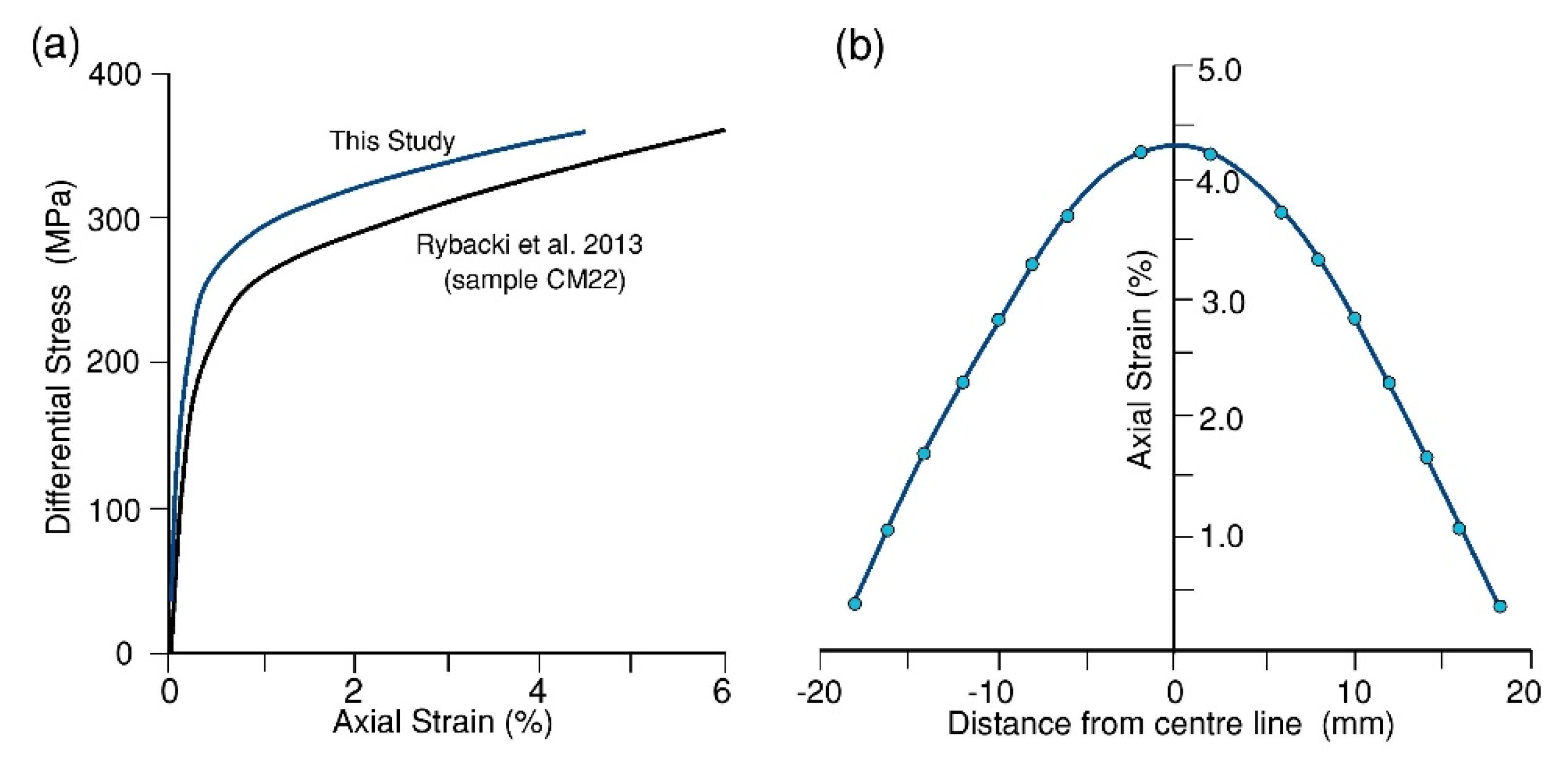
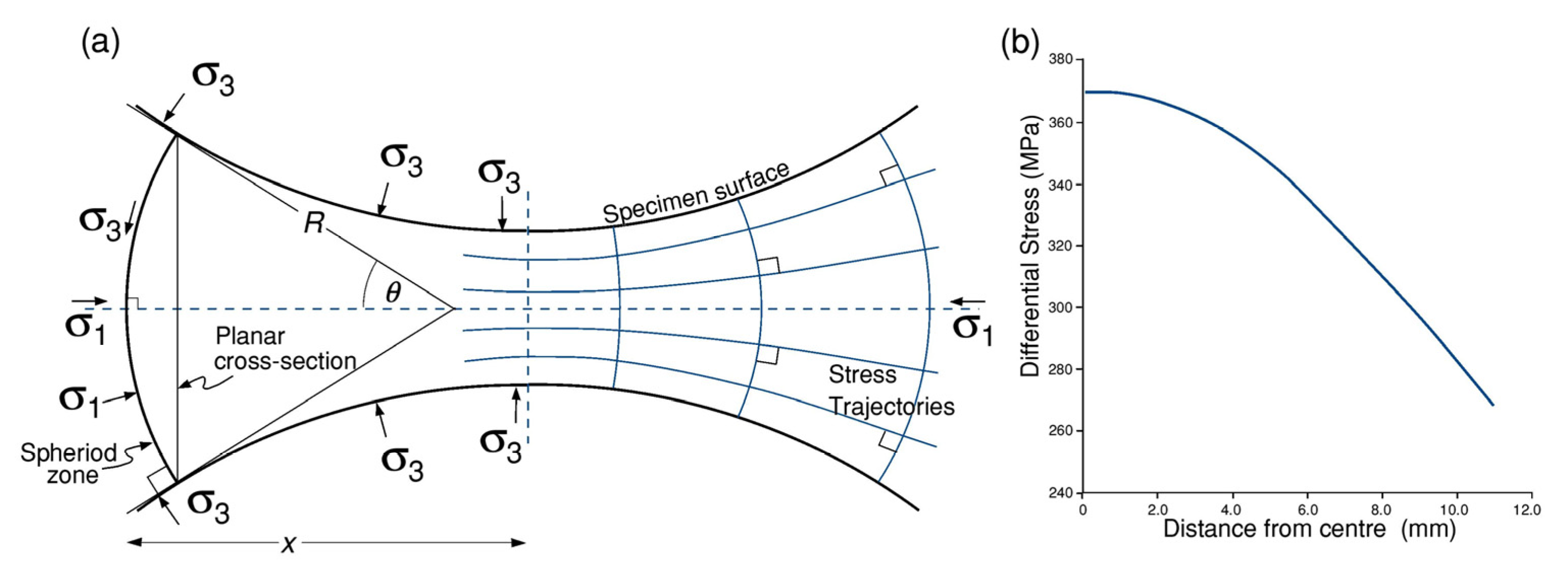

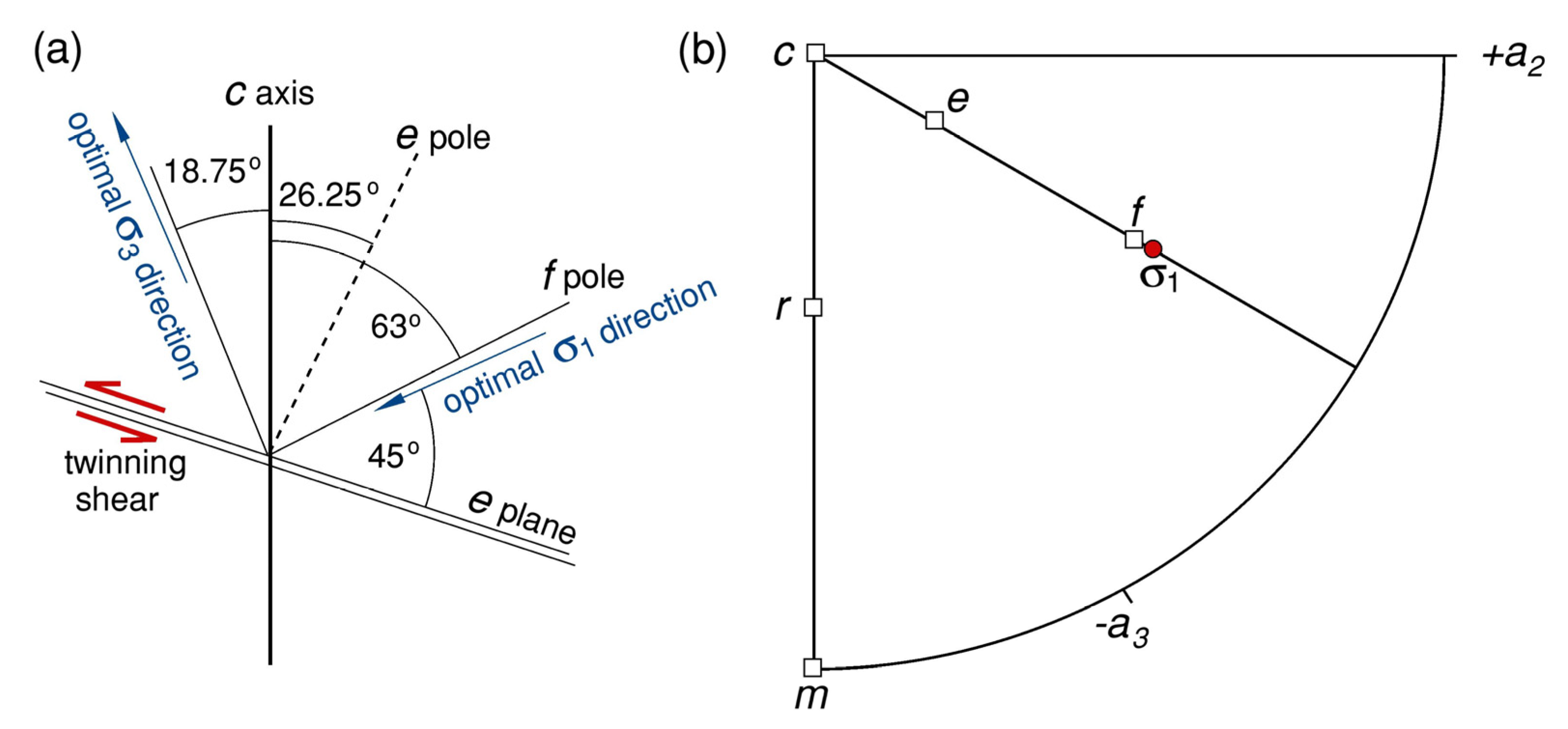
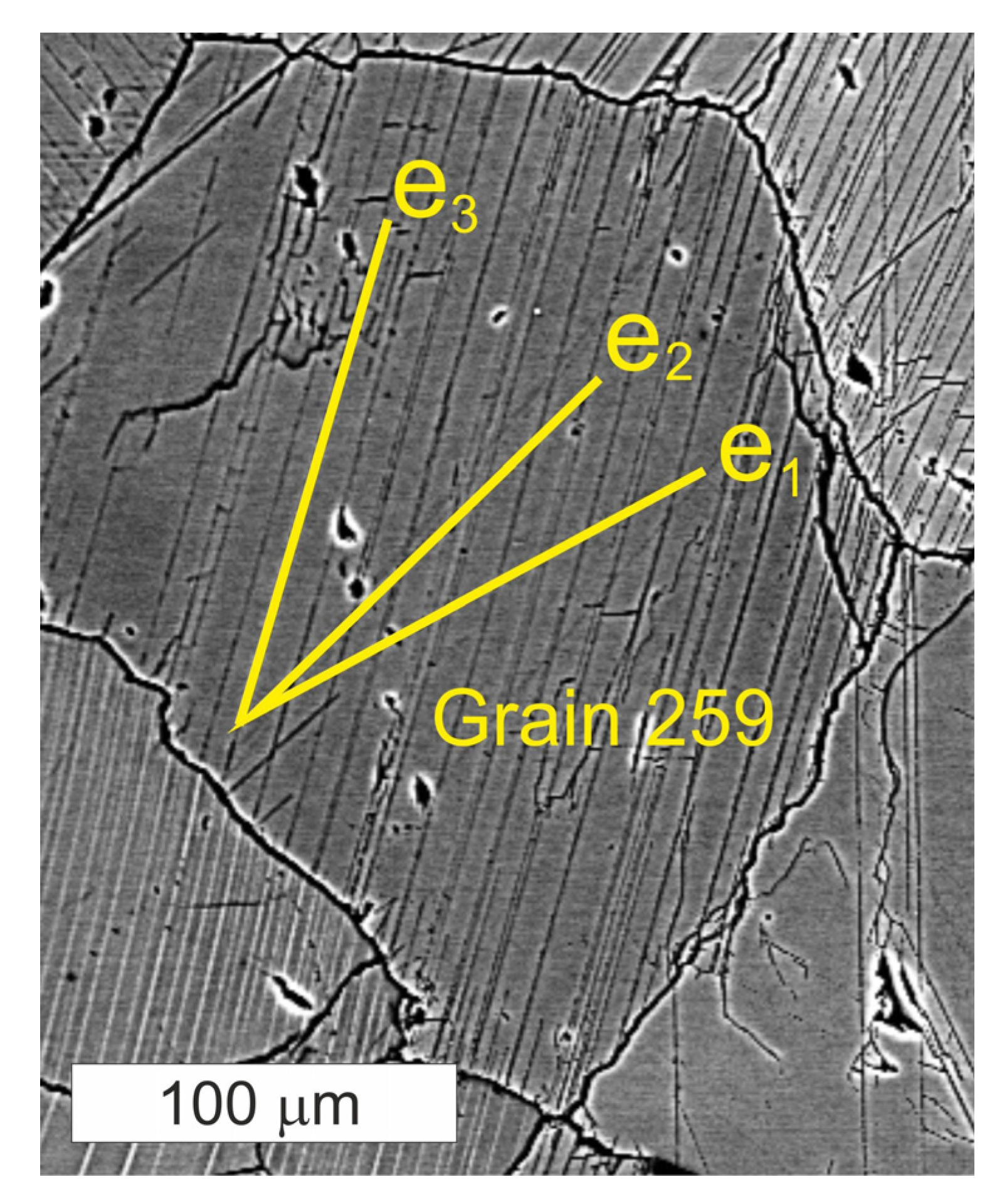
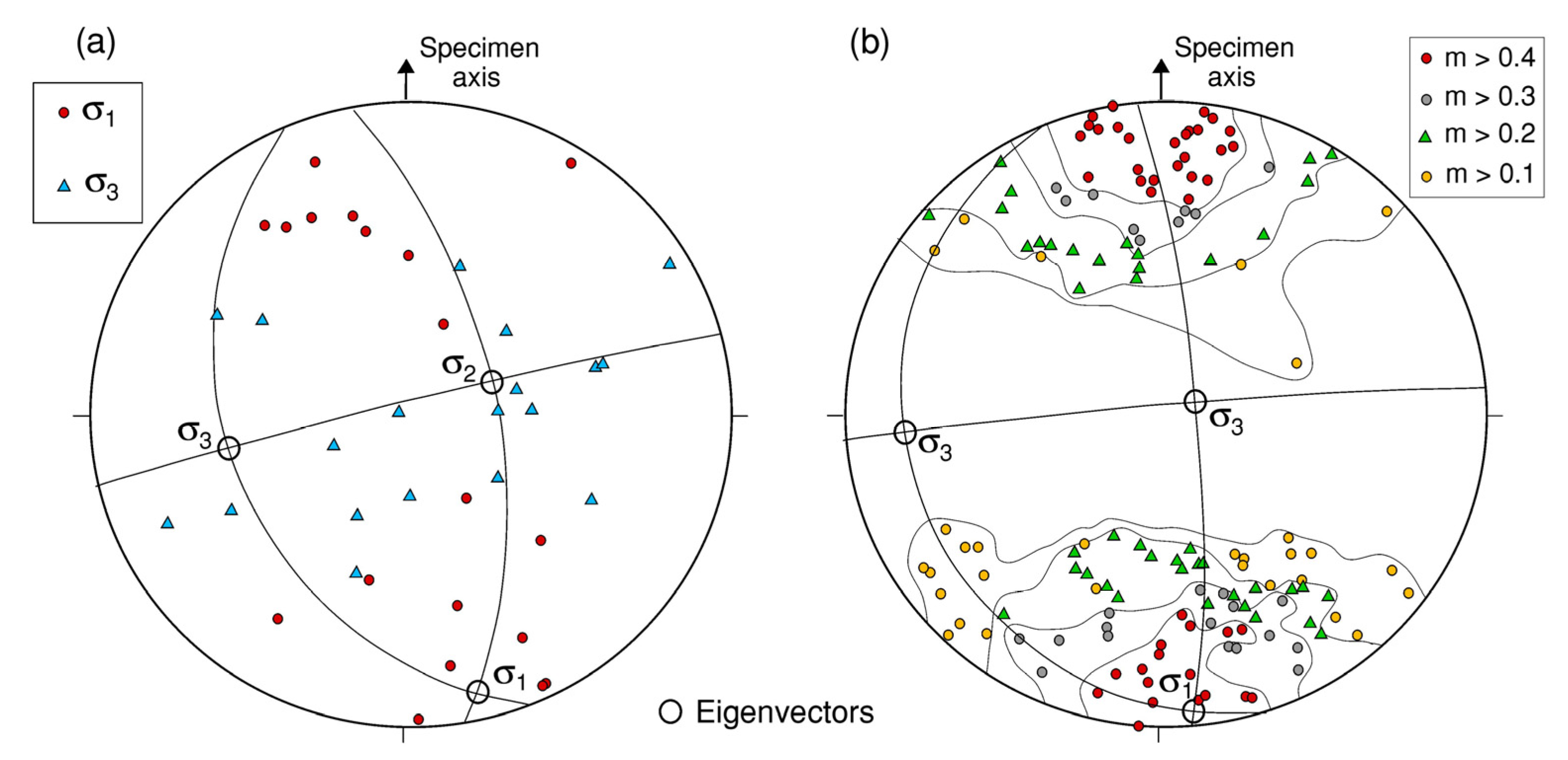
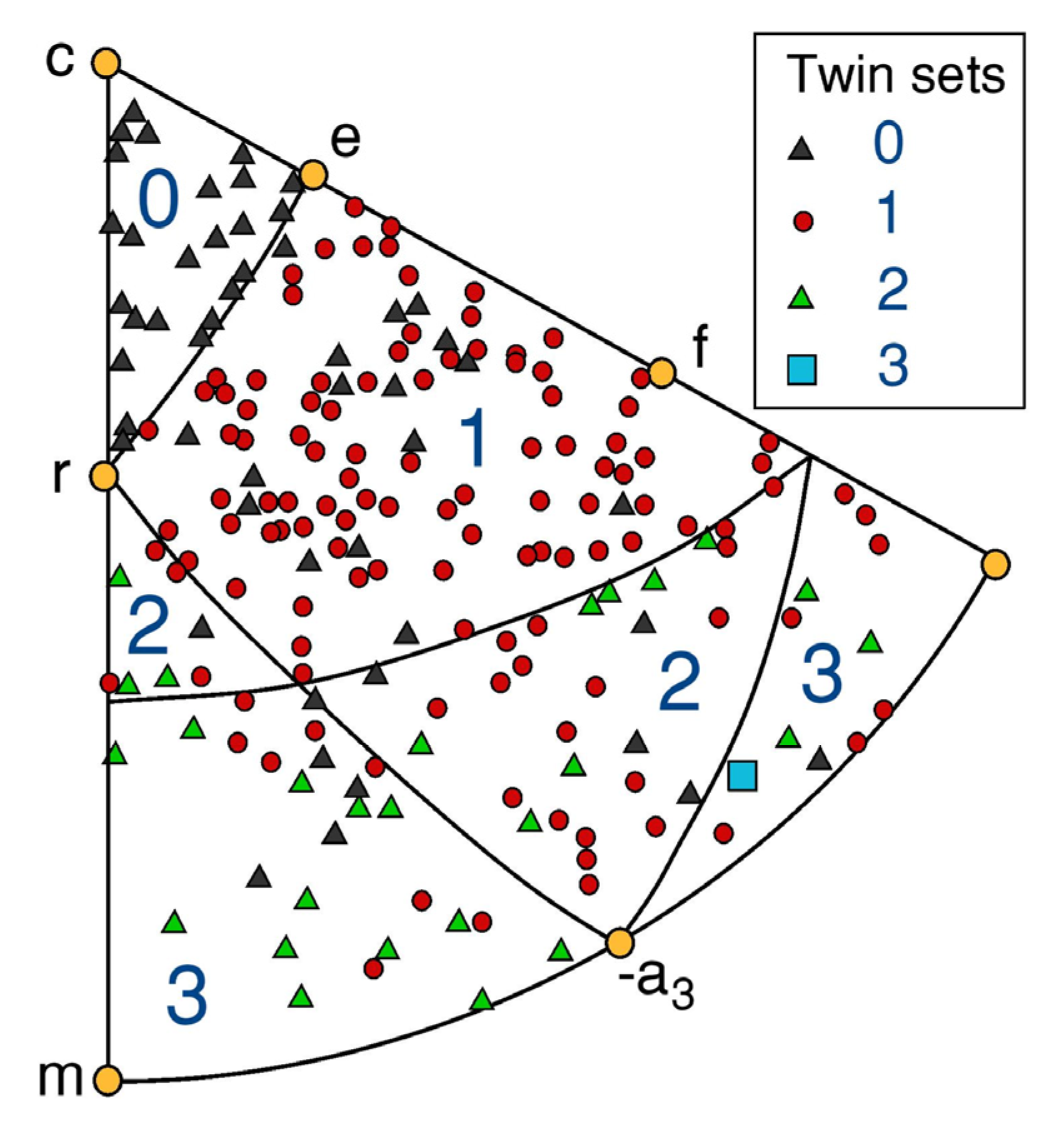
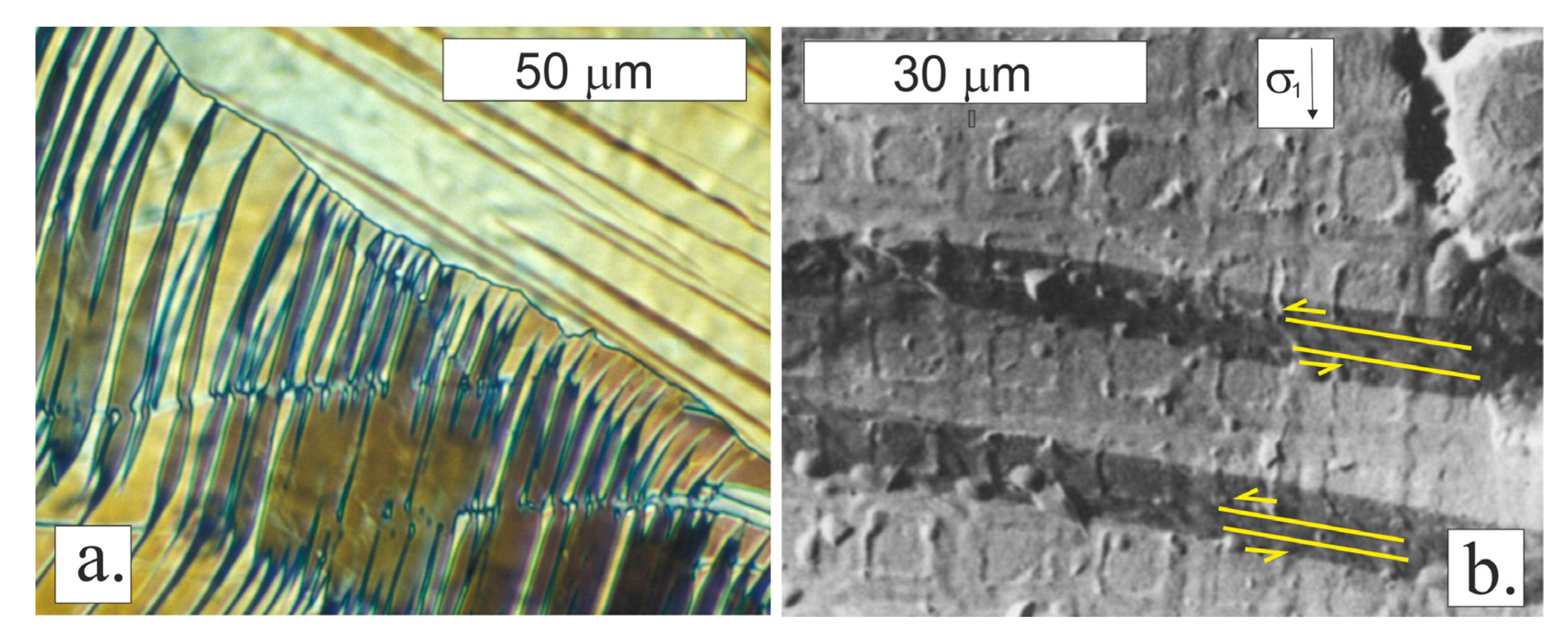
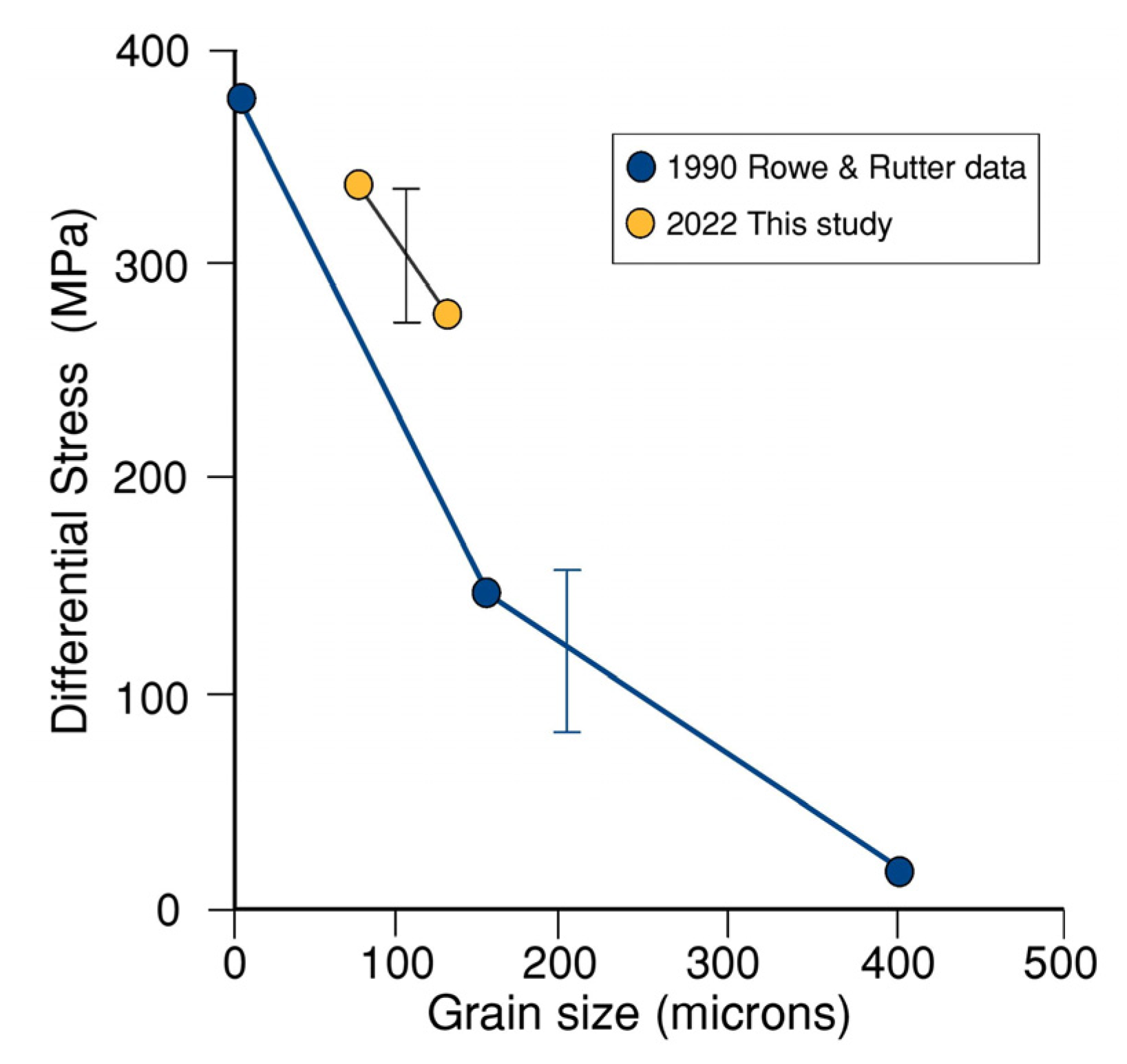


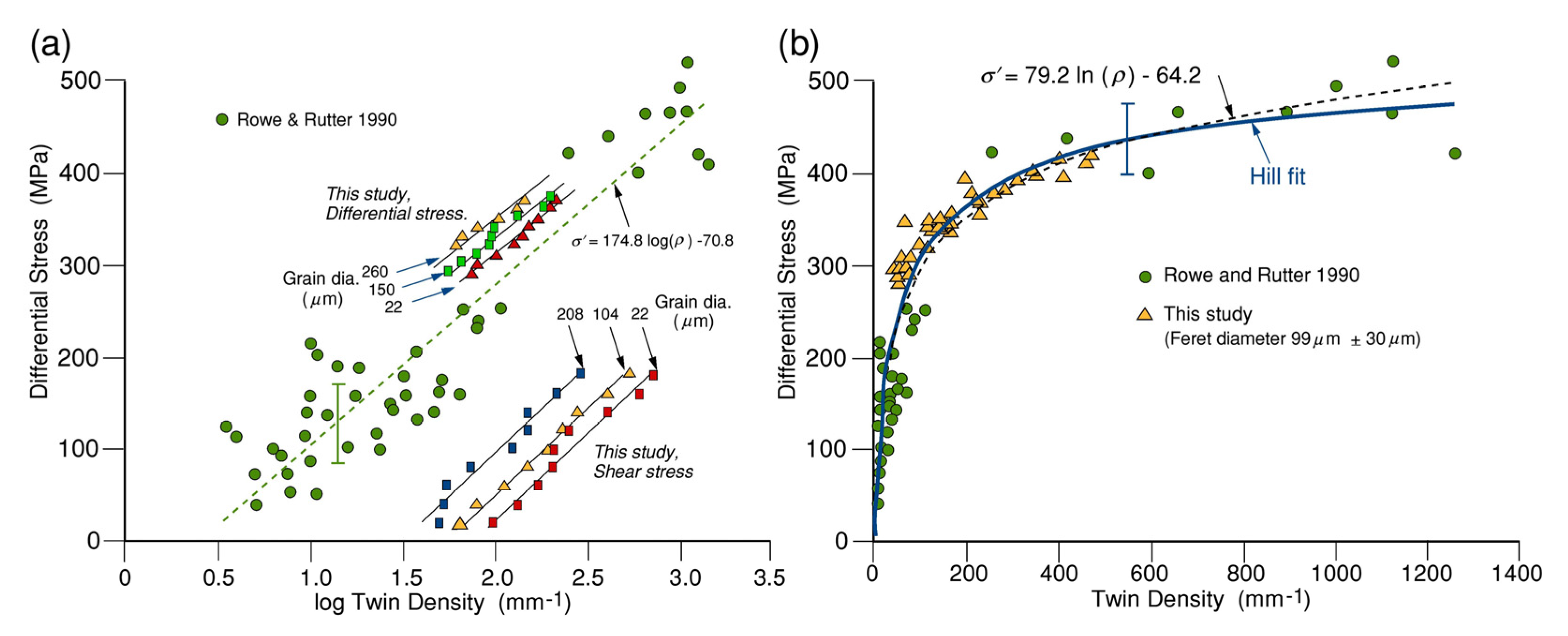
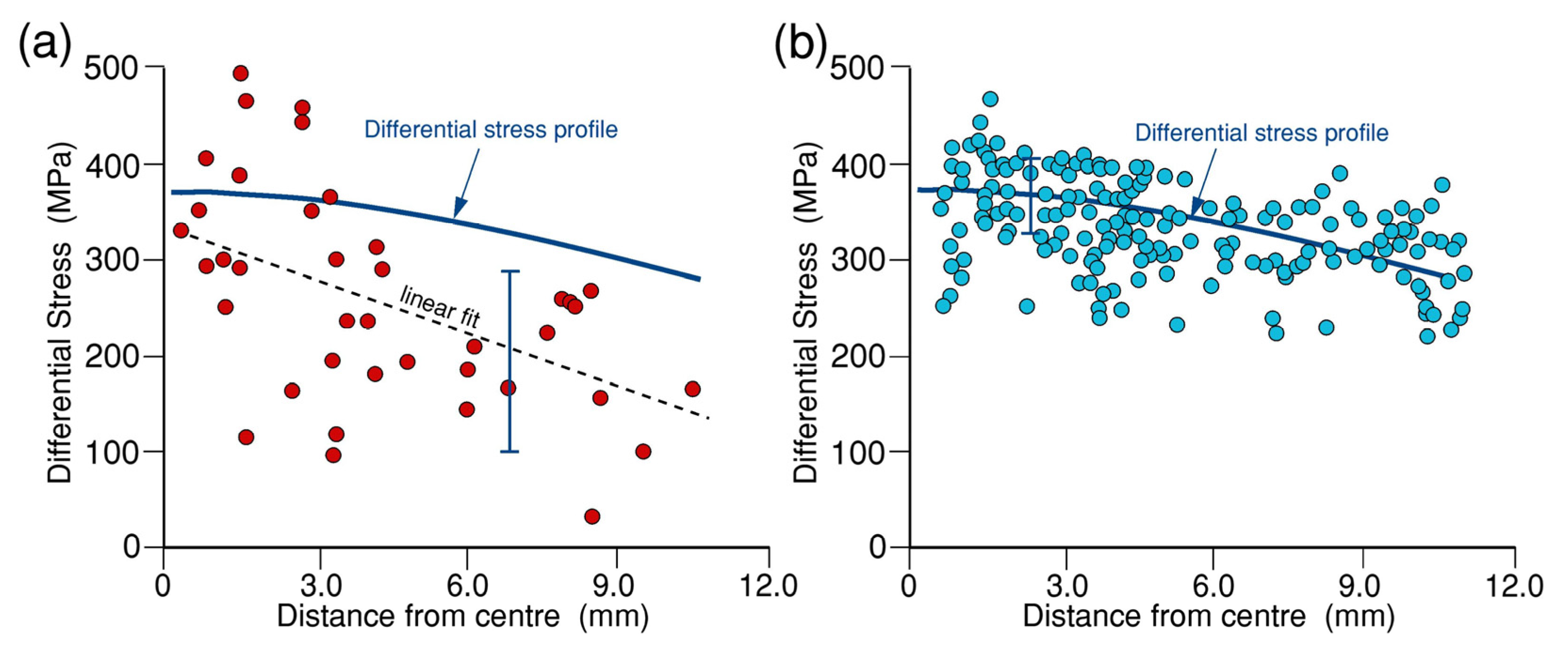
Publisher’s Note: MDPI stays neutral with regard to jurisdictional claims in published maps and institutional affiliations. |
© 2022 by the authors. Licensee MDPI, Basel, Switzerland. This article is an open access article distributed under the terms and conditions of the Creative Commons Attribution (CC BY) license (https://creativecommons.org/licenses/by/4.0/).
Share and Cite
Rutter, E.; Wallis, D.; Kosiorek, K. Application of Electron Backscatter Diffraction to Calcite-Twinning Paleopiezometry. Geosciences 2022, 12, 222. https://doi.org/10.3390/geosciences12060222
Rutter E, Wallis D, Kosiorek K. Application of Electron Backscatter Diffraction to Calcite-Twinning Paleopiezometry. Geosciences. 2022; 12(6):222. https://doi.org/10.3390/geosciences12060222
Chicago/Turabian StyleRutter, Ernest, David Wallis, and Kamil Kosiorek. 2022. "Application of Electron Backscatter Diffraction to Calcite-Twinning Paleopiezometry" Geosciences 12, no. 6: 222. https://doi.org/10.3390/geosciences12060222
APA StyleRutter, E., Wallis, D., & Kosiorek, K. (2022). Application of Electron Backscatter Diffraction to Calcite-Twinning Paleopiezometry. Geosciences, 12(6), 222. https://doi.org/10.3390/geosciences12060222





